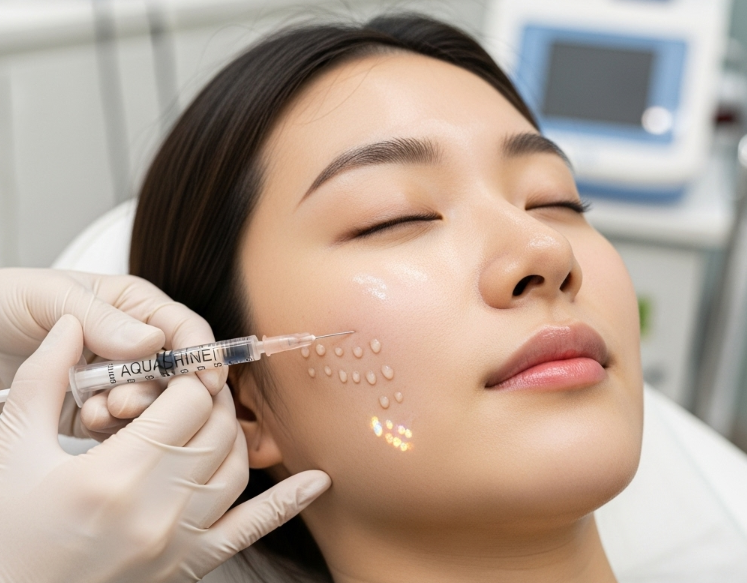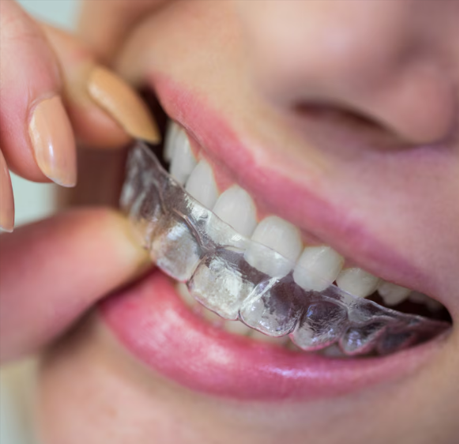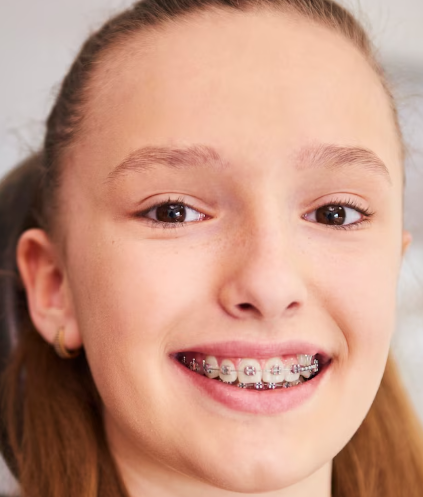Treatment Overview
Aquashine is one of Korea’s most popular multi-functional skin boosters, combining hyaluronic acid (HA) with peptides, amino acids, vitamins, and antioxidants. It is widely used to address hydration, pigmentation, fine wrinkles, and skin dullness. Patients love Aquashine because it delivers both deep hydration and skin brightening, making it a top choice for achieving the Korean “glass skin” look.
It is often compared with Exosome Therapy, another breakthrough treatment in Korea:
- Aquashine: Improves hydration, pigmentation, and glow with nutrient infusion.
- Exosome Therapy: Focuses on cell regeneration, collagen stimulation, and post-treatment healing at a deeper level.
Many Korean dermatologists recommend combining Aquashine with Exosome Therapy—Aquashine provides hydration and brightening, while exosomes accelerate repair, boost collagen, and strengthen overall skin health.
Purpose & Benefits
- Hydration Boost: HA replenishes moisture for plump, glowing skin.
- Wrinkle Softening: Smooths fine lines and early signs of aging.
- Brightening Effect: Reduces pigmentation, melasma, and dullness.
- Elasticity & Firmness: Peptides stimulate fibroblasts for resilience.
- Texture Refinement: Shrinks pores and smooths roughness.
- Preventive Anti-Aging: Protects skin against early aging.
- Synergy with Exosomes: Enhances healing, collagen remodeling, and long-term results.
Ideal Candidates
Aquashine in Korea is recommended for:
- Adults in their 20s–50s with dry, uneven, or dull skin.
- Patients with pigmentation, acne marks, or enlarged pores.
- Men and women comparing Aquashine vs Exosome Therapy:
- Aquashine: Best for hydration, glow, and pigmentation care.
- Exosome Therapy: Best for regeneration, collagen, and scar repair.
- Patients interested in dual protocols for both instant glow and deep repair.
Possible Risks & Complications
Aquashine is safe when performed by expert dermatologists in Korea, but mild side effects may include:
- Redness or Pinpoint Bumps: Common post-injection, fade in 24–48 hours.
- Swelling or Bruising: Temporary, especially around delicate areas.
- Dryness or Flaking: May occur as skin regenerates.
- Rare Risks: Allergic reaction or infection (minimized in Korea’s clinics).
Surgical Techniques Used
Although non-surgical, Aquashine requires high-precision medical techniques:
- Micro-Injections: Nutrient-rich HA formula delivered intradermally.
- Meso-Gun Delivery: Automated injector ensures even distribution.
- Customized Mapping: Adjusted for pigmentation, wrinkles, or hydration needs.
- Aquashine Variants:
- Aquashine BR: Brightening and pigmentation correction.
- Aquashine BTX: Wrinkle care with peptide-rich formula.
- Combination Therapy: Often paired with Exosome Therapy, PRP, or lasers.
- Multi-Session Protocol: 3–4 treatments spaced 3–4 weeks apart.
Recovery & Aftercare
- Immediately After: Redness, small bumps, or swelling.
- 1–3 Days: Skin calms; hydration and glow become visible.
- 2–4 Weeks: Pigmentation fades, wrinkles soften, and skin tone evens.
- Multiple Sessions: Recommended for sustained and long-lasting results.
Aftercare Tips:
- Avoid makeup for 24 hours.
- Apply SPF 50+ daily.
- Keep skin hydrated with gentle moisturizers.
- Avoid alcohol, sauna, and strenuous activity for 1–2 days.
Results & Longevity
- Immediate: Fresher, more hydrated skin.
- Short-Term (2–4 Weeks): Glow and brightness improve; pores refine.
- Medium-Term (2–3 Months): Wrinkle reduction and tone correction peak.
- Long-Term: Results last 6–12 months, with maintenance recommended twice yearly.
- Exosome Combination: Extends benefits up to 12–18 months through deeper repair.
Treatment Process in Korea
- Consultation & Skin Analysis – Doctor evaluates wrinkles, pigmentation, and texture.
- Preparation – Cleansing; numbing cream applied.
- Injection Session – Aquashine injected via micro-needle or meso-gun.
- Exosome Add-On (Optional): Exosome serum infused via microneedling or post-laser application.
- Post-Care – Cooling masks, exosome serums, or LED light therapy applied.
- Follow-Up – 3–4 sessions recommended for cumulative results.
Why Korea is a Top Destination
- Korea is a global leader in skin boosters and regenerative therapies.
- Access to both authentic Aquashine formulations and KFDA-approved exosomes.
- Dermatologists use advanced combination protocols for glow + regeneration.
- Affordable compared to Western clinics while offering superior expertise.
- Seoul is known as the epicenter of skin booster + exosome innovation.
Cost Range (Detailed Breakdown)
Pricing for Aquashine in Korea depends on formulation and package:
- Aquashine BR (per syringe): USD 250 – 400
- Aquashine BTX (per syringe): USD 300 – 500
- Full Face (2–3 syringes): USD 600 – 1,200
- 3-Session Package (recommended): USD 1,200 – 2,500
- Aquashine + Exosome Combo: USD 700 – 1,500 per session
- Luxury Glow Package (Aquashine + Exosomes/PRP + Laser): USD 2,000 – 4,000
Additional Costs in Korea:
- Consultation: USD 20 – 50
- Numbing & aftercare: USD 20 – 40
- Add-ons (PRP, exosomes, HA boosters): USD 200 – 800
💡 Patients often call Aquashine the “glow booster” and Exosomes the “healing booster.” When combined, they deliver one of the most complete skin rejuvenation protocols in Korea.
Popular Clinics
- Banobagi Dermatology (Seoul): Experts in Aquashine + exosome synergy.
- Oracle Dermatology (Seoul): Offers Aquashine BR/BTX with regenerative add-ons.
- Renewme Skin Clinic (Seoul): Specialists in acne scar repair using Aquashine + exosomes.
- View Plastic & Dermatology (Seoul): Combines Aquashine with PDO threads and exosome boosters.
- Chaum Anti-Aging Center (Seoul): Luxury Aquashine + exosome programs with holistic care.




